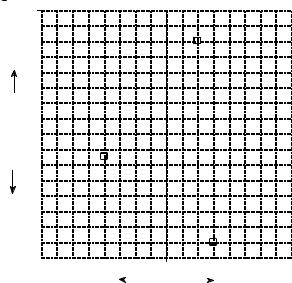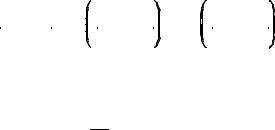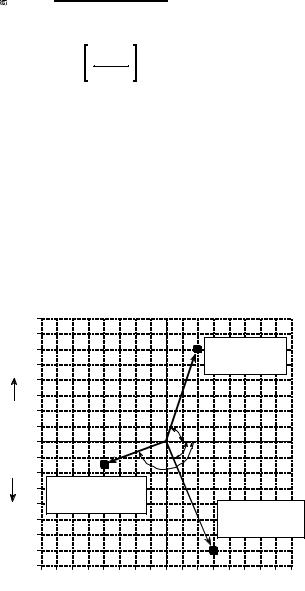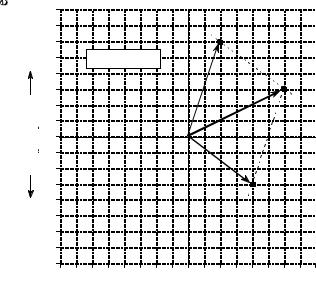
TsOS / DSP_guide_Smith / Ch30
.pdf
CHAPTER
Complex Numbers
30
Complex numbers are an extension of the ordinary numbers used in everyday math. They have the unique property of representing and manipulating two variables as a single quantity. This fits very naturally with Fourier analysis, where the frequency domain is composed of two signals, the real and the imaginary parts. Complex numbers shorten the equations used in DSP, and enable techniques that are difficult or impossible with real numbers alone. For instance, the Fast Fourier Transform is based on complex numbers. Unfortunately, complex techniques are very mathematical, and it requires a great deal of study and practice to use them effectively. Many scientists and engineers regard complex techniques as the dividing line between DSP as a tool, and DSP as a career. In this chapter, we look at the mathematics of complex numbers, and elementary ways of using them in science and engineering. The following three chapters discuss important techniques based on complex numbers: the complex Fourier transform, the Laplace transform, and the z-transform. These complex transforms are the heart of theoretical DSP. Get ready, here comes the math!
The Complex Number System
To illustrate complex numbers, consider a child throwing a ball into the air. For example, assume that the ball is thrown straight up, with an initial velocity of 9.8 meters per second. One second after it leaves the child's hand, the ball has reached a height of 4.9 meters, and the acceleration of gravity (9.8 meters per second2) has reduced its velocity to zero. The ball then accelerates toward the ground, being caught by the child two seconds after it was thrown. From basic physics equations, the height of the ball at any instant of time is given by:
|
& g t 2 |
||
h ' |
|
% v t |
|
2 |
|||
|
|
||
551

552 |
The Scientist and Engineer's Guide to Digital Signal Processing |
where h is the height above the ground (in meters), g is the acceleration of gravity (9.8 meters per second2), v is the initial velocity (9.8 meters per second), and t is the time (in seconds).
Now, suppose we want to know when the ball passes a certain height. Plugging in the known values and solving for t:
t ' 1 ±  1& h /4.9
1& h /4.9
For instance, the ball is at a height of 3 meters twice: t ' 0.38 (going up) and t ' 1.62 seconds (going down).
As long as we ask reasonable questions, these equations give reasonable answers. But what happens when we ask unreasonable questions? For example: At what time does the ball reach a height of 10 meters? This question has no answer in reality because the ball never reaches this height. Nevertheless, plugging the value of h ' 10 into the above equation gives two answers: t ' 1 %  & 1.041 and t ' 1 &
& 1.041 and t ' 1 &  & 1.041 . Both these answers contain the square-root of a negative number, something that does not exist in the world as we know it. This unusual property of polynomial equations was first used by the Italian mathematician Girolamo Cardano (1501-1576). Two centuries later, the great German mathematician Carl Friedrich Gauss (1777-1855) coined the term complex numbers, and paved the way for the modern understanding of the field.
& 1.041 . Both these answers contain the square-root of a negative number, something that does not exist in the world as we know it. This unusual property of polynomial equations was first used by the Italian mathematician Girolamo Cardano (1501-1576). Two centuries later, the great German mathematician Carl Friedrich Gauss (1777-1855) coined the term complex numbers, and paved the way for the modern understanding of the field.
Every complex number is the sum of two components: a real part and an imaginary part. The real part is a real number, one of the ordinary numbers we all learned in childhood. The imaginary part is an imaginary number, that is, the square-root of a negative number. To keep things standardized, the imaginary part is usually reduced to an ordinary number multiplied by the square-root of negative one. As an example, the complex
|
|
|
|
|
|
|
number: t ' 1 % & 1.041 , is first reduced to: t ' 1 % 1.041 & 1 , and then to |
||||||
the final form: t ' 1 % 1.02 |
& 1 |
. |
The real part of this complex number is 1, |
|||
while the imaginary part is 1.02 |
& 1 |
. This notation allows the abstract term, |
||||
& 1 |
, to be given a special symbol. Mathematicians have long used i to denote |
& 1 |
. In comparison, electrical engineers use the symbol, j, because i is used |
to represent electrical current. Both symbols are common in DSP. In this book the electrical engineering convention, j, will be used.
For example, all the following are valid complex numbers: 1 % 2 j , 1 & 2 j , & 1 % 2 j , 3.14159 % 2.7183 j , (4/3) % (19/2) j , etc. All ordinary numbers, such as: 2, 6.34, and -1.414, can be viewed as a complex number with zero for the imaginary part, i.e., 2 % 0 j , 6.34 % 0 j , and & 1.414 % 0 j .
Just as real numbers are described as having positions along a number line, complex numbers are represented by locations in a two-dimensional display called the complex plane. As shown in Fig. 30-1, the horizontal axis of the

Chapter 30Complex Numbers |
553 |
FIGURE 30-1
The complex plane. Every complex number has a unique location in the complex plane, as illustrated by the three examples shown here. The horizontal axis represents the real part, while the vertical axis represents the imaginary part.
Imaginary axis
8j
7j |
|
|
|
|
|
|
|
|
|
|
|
|
|
|
|
|
|
|
|
|
|
|
|
|
|
2 + 6 j |
|
|
||||||||||||
|
|
|
|
|
|
|
|
|
|
|
|
|
|
|
|
|
|
|
|
|
|
|
|
|||||||||||||||||
6j |
|
|
|
|
|
|
|
|
|
|
|
|
|
|
|
|
|
|
|
|
|
|
|
|
|
|
|
|
|
|
|
|
|
|
|
|
|
|
|
|
5j |
|
|
|
|
|
|
|
|
|
|
|
|
|
|
|
|
|
|
|
|
|
|
|
|
|
|
|
|
|
|
|
|
|
|
|
|
|
|
|
|
|
|
|
|
|
|
|
|
|
|
|
|
|
|
|
|
|
|
|
|
|
|
|
|
|
|
|
|
|
|
|
|
|
|
|
|
|
|
|
|
|
4j |
|
|
|
|
|
|
|
|
|
|
|
|
|
|
|
|
|
|
|
|
|
|
|
|
|
|
|
|
|
|
|
|
|
|
|
|
|
|
|
|
|
|
|
|
|
|
|
|
|
|
|
|
|
|
|
|
|
|
|
|
|
|
|
|
|
|
|
|
|
|
|
|
|
|
|
|
|
|
|
|
|
3j |
|
|
|
|
|
|
|
|
|
|
|
|
|
|
|
|
|
|
|
|
|
|
|
|
|
|
|
|
|
|
|
|
|
|
|
|
|
|
|
|
|
|
|
|
|
|
|
|
|
|
|
|
|
|
|
|
|
|
|
|
|
|
|
|
|
|
|
|
|
|
|
|
|
|
|
|
|
|
|
|
|
2j |
|
|
|
|
|
|
|
|
|
|
|
|
|
|
|
|
|
|
|
|
|
|
|
|
|
|
|
|
|
|
|
|
|
|
|
|
|
|
|
|
|
|
|
|
|
|
|
|
|
|
|
|
|
|
|
|
|
|
|
|
|
|
|
|
|
|
|
|
|
|
|
|
|
|
|
|
|
|
|
|
|
1j |
|
|
|
|
|
|
|
|
|
|
|
|
|
|
|
|
|
|
|
|
|
|
|
|
|
|
|
|
|
|
|
|
|
|
|
|
|
|
|
|
|
|
|
|
|
|
|
|
|
|
|
|
|
|
|
|
|
|
|
|
|
|
|
|
|
|
|
|
|
|
|
|
|
|
|
|
|
|
|
|
|
0j |
|
|
|
|
|
|
|
|
|
|
|
|
|
|
|
|
|
|
|
|
|
|
|
|
|
|
|
|
|
|
|
|
|
|
|
|
|
|
|
|
|
|
|
|
|
|
|
|
|
|
|
|
|
|
|
|
|
|
|
|
|
|
|
|
|
|
|
|
|
|
|
|
|
|
|
|
|
|
|
|
|
--1j |
|
|
|
|
|
|
|
|
|
|
|
|
|
|
|
|
|
|
|
|
|
|
|
|
|
|
|
|
|
|
|
|
|
|
|
|
|
|
|
|
|
|
|
|
|
|
|
|
|
|
|
|
|
|
|
|
|
|
|
|
|
|
|
|
|
|
|
|
|
|
|
|
|
|
|
|
|
|
|
|
|
--2j |
|
|
|
|
|
|
|
|
|
|
|
|
|
|
|
|
|
|
|
|
|
|
|
|
|
|
|
|
|
|
|
|
|
|
|
|
|
|
|
|
|
|
|
-4 - 1.5 j |
|
|
|
|
|
|
|
|
|||||||||||||||||||||||||||||
|
|
|||||||||||||||||||||||||||||||||||||||
--3j |
|
|
|
|
|
|
|
|
|
|
|
|
|
|
|
|
|
|
|
|
|
|
|
|
|
|
|
|
|
|
|
|
|
|
|
|
|
|
|
|
|
|
|
|
|
|
|
|
|
|
|
|
|
|
|
|
|
|
|
|
|
|
|
|
|
|
|
|
|
|
|
|
|
|
|
|
|
|
|
|
|
--4j |
|
|
|
|
|
|
|
|
|
|
|
|
|
|
|
|
|
|
|
|
|
|
|
|
|
|
|
|
|
|
|
|
|
|
|
|
|
|
|
|
|
|
|
|
|
|
|
|
|
|
|
|
|
|
|
|
|
|
|
|
|
|
|
|
|
|
|
|
|
|
|
|
|
|
|
|
|
|
|
|
|
--5j |
|
|
|
|
|
|
|
|
|
|
|
|
|
|
|
|
|
|
|
|
|
|
|
|
|
|
|
|
|
|
|
|
|
|
|
|
|
|
|
|
|
|
|
|
|
|
|
|
|
|
|
|
|
|
|
|
|
|
|
|
|
|
|
|
|
|
|
|
|
|
|
|
|
|
|
|
|
|
|
|
|
--6j |
|
|
|
|
|
|
|
|
|
|
|
|
|
|
|
|
|
|
|
|
|
|
|
|
|
|
|
|
|
|
|
|
|
|
|
|
|
|
|
|
|
|
|
|
|
|
|
|
|
|
|
|
|
|
|
|
|
|
|
|
|
|
|
|
|
|
|
|
|
|
|
|
|
|
|
|
|
|
|
|
|
--7j |
|
|
|
|
|
|
|
|
|
|
|
|
|
|
|
|
|
|
|
|
|
|
|
|
|
|
|
|
|
|
|
|
||||||||
|
|
|
|
|
|
|
|
|
|
|
|
|
|
|
|
|
|
|
|
|
|
|
|
|
|
|
|
|
|
3 - 7 j |
|
|
|
|
|
|||||
--8j |
|
|
|
|
|
|
|
|
|
|
|
|
|
|
|
|
|
|
|
|
|
|
|
|
|
|
|
|
|
|
|
|
|
|
|
|
|
|
|
|
|
-8 -7 -6 -5 -4 -3 -2 -1 0 1 2 3 4 5 6 7 8 |
|||||||||||||||||||||||||||||||||||||||
|
|
|
|
|
|
|
|
|
|
|
|
|
|
|
|
|
Real axis |
|
|
|
|
|
|
|
|
|||||||||||||||
|
|
|
|
|
|
|
|
|
|
|
|
|
|
|
|
|
|
|
|
|
||||||||||||||||||||
complex plane is the real part of the complex number, while the vertical axis is the imaginary part. Since real numbers are those complex numbers that have an imaginary part equal to zero, the real number line is the same as the x-axis of the complex plane.
In mathematical equations, a complex number is represented by a single variable, even though it is composed of two parts. For example, the three complex variables in Fig. 30-1 could be written:
A ' 2 % 6 j
B' & 4 & 1.5 j
C' 3 & 7 j
where A, B, & C are complex variables. This illustrates a strong advantage and a strong disadvantage of using complex numbers. The advantage is the inherent shorthand of representing two things by a single symbol. The disadvantage is having to remember which variables are complex and which variables are ordinary numbers.
The mathematical notation for separating a complex number into its real and imaginary parts uses the operators: Re ( ) and Im ( ) . For example, using the above complex numbers:
Re A = 2 |
Im A = 6 |
|
Re B |
= -4 |
Im B = -1.5 |
Re C |
= 3 |
Im C = -7 |

554 The Scientist and Engineer's Guide to Digital Signal Processing
Notice that the value returned by the mathematical operator, Im ( ), does not include the j. For example, Im (3 % 4 j ) is equal to 4, not 4 j .
Complex numbers follow the same algebra as ordinary numbers, treating the quantity, j, as a constant. For instance, addition, subtraction, multiplication and division are given by:
EQUATION 30-1
Addition of complex numbers.
EQUATION 30-2
Subtraction of complex numbers.
EQUATION 30-3
Multiplication of complex numbers.
EQUATION 30-4
Division of complex numbers.
(a % b j ) % (c % d j ) ' (a % c ) % j (b % d )
(a % b j ) & (c % d j ) ' (a & c ) % j (b & d )
(a % b j ) (c % d j ) ' (ac & bd ) % j (bc % ad )
(a % b j ) |
' |
a c % b d |
% j |
|
|
b c & a d |
|
||||||
|
||||||
|
|
|
|
c 2 % d 2 |
||
(c % d j ) |
c 2 % d 2 |
|
|
|||
Two tricks are used when manipulating equations such as these. First, whenever a j 2 term is encountered, it is replaced by -1. This follows from the definition of j, that is: j 2 ' ( & 1 )2 ' & 1 . The second trick is a way to eliminate the j term from the denominator of a fraction. For instance, the left side of Eq. 30-4 has a denominator of c % d j . This is handled by multiplying the numerator and denominator by the term c & jd , cancelling all the imaginary terms from the denominator. In the jargon of the field, switching the sign of the imaginary part of a complex number is called taking the complex conjugate. This is denoted by a star at the upper right corner of the variable. For example, if Z ' a % b j , then Z t ' a & b j . In other words, Eq. 30- 4 is derived by multiplying both the numerator and denominator by the complex conjugate of the denominator.
& 1 )2 ' & 1 . The second trick is a way to eliminate the j term from the denominator of a fraction. For instance, the left side of Eq. 30-4 has a denominator of c % d j . This is handled by multiplying the numerator and denominator by the term c & jd , cancelling all the imaginary terms from the denominator. In the jargon of the field, switching the sign of the imaginary part of a complex number is called taking the complex conjugate. This is denoted by a star at the upper right corner of the variable. For example, if Z ' a % b j , then Z t ' a & b j . In other words, Eq. 30- 4 is derived by multiplying both the numerator and denominator by the complex conjugate of the denominator.
The following properties hold even when the variables A, B, and C are complex. These relations can be proven by breaking each variable into its real and imaginary parts and working out the algebra.
EQUATION 30-5 Commutative property.
EQUATION 30-6 Associative property.
EQUATION 30-7 Distributive property.
A B ' B A
(A % B ) % C ' A % (B % C )
A (B % C ) ' AB % AC

Chapter 30Complex Numbers |
555 |
Polar Notation
Complex numbers can also be expressed in polar notation, besides the rectangular notation just described. For example, Fig. 30-2 shows three complex numbers in polar form, the same ones previously presented in Fig. 30-1. The magnitude is the length of the vector starting at the origin and ending at the complex point, while the phase angle is measured between this vector and the positive x-axis. Complex numbers can be converted between rectangular and polar notation by the following equations (paying attention to the polar notation nuisances discussed in Chapter 8):
EQUATION 30-8
Rectangular-to-polar conversion. The complex variable, A, can be changed from rectangular form: Re A & Im A, to polar form: M & 2.
EQUATION 30-9
Polar-to-rectangular conversion. This is changing the complex number from M & 2 to Re A & Im A.
M '  (Re A)2 % (Im A)2
(Re A)2 % (Im A)2
Im A
2 ' arctan
Re A
Re A ' M cos (2)
Im A ' M sin(2)
This brings up a giant leap in the mathematics. (Yes, this means you should pay extra attention). A complex number written in rectangular notation
FIGURE 30-2
Complex numbers in polar form. Three example points in the complex plane are shown in polar coordinates. Figure 30-1 shows these same points in rectangular form.
|
8j |
|
|
|
7j |
|
2 + 6 j or |
|
6j |
|
|
|
|
M = %85 |
|
|
5j |
|
|
|
|
2 = arctan (6/2) |
|
|
4j |
|
|
|
3j |
|
|
axis |
2j |
|
|
1j |
|
|
|
Imaginary |
|
|
|
0j |
|
|
|
--1j |
|
|
|
--2j |
|
|
|
|
|
|
|
|
--3j |
-4 - 1.5 j or |
|
|
M = %18.25 |
|
|
|
--4j |
|
|
|
2 = arctan (-1.5/-4) |
3 - 7 j or |
|
|
- |
|
M = %58 |
|
-5j |
|
|
|
--6j |
|
2 = arctan (-7/3) |
|
|
|
|
|
--7j |
|
|
|
--8j |
|
|
|
|
-8 -7 -6 -5 -4 -3 -2 -1 0 1 2 3 4 5 6 7 8 |
|
 Real axis
Real axis 

556 |
The Scientist and Engineer's Guide to Digital Signal Processing |
is in the form: a % b j . The information is carried in the variables: a & b , but the proper complex number is the entire expression: a % b j . In polar form, the key information is contained in M & 2, but what is the full expression for the proper complex number?
The key to this is Eq. 30-9, the polar-to-rectangular conversion. If we start with the proper complex number, a % b j , and apply Eq. 30-9, we obtain:
EQUATION 30-10
Rectangular and polar complex numbers. The left side is the rectangular form of a complex number, while the expression on the right is the polar representation. The conversion between: M & 2 and a & b, is given by Eqs. 30-8 and 30-9.
a % j b ' M ( cos 2 % j sin 2 )
The expression on the left is the proper rectangular description of a complex number, while the expression on the right is the proper polar description.
Before continuing with the next step, let's review how we arrived at this point. First, we gave the rectangular form of a complex number a graphical representation, that is, a location in a two-dimensional plane. Second, we defined the terms M & 2 to be consistent with our previous experience about the relationship between polar and rectangular coordinates (Eq. 30-8 and 30-9). Third, we followed the mathematical consequences of these actions, arriving at what the correct polar form of a complex number must be, i . e . , M (cos2% j sin 2) . Even though this logic is straightforward, the result is difficult to see with "intuition." Unfortunately, it gets worse.
One of the most important equations in complex mathematics is Euler's relation, named for the clever and very prolific Swiss mathematician, Leonhard Euler (1707-1783; Euler is pronounced: "Oiler"):
EQUATION 30-11 |
|
|
e jx ' cos x % j sin x |
|
|
|
|
|
|
|
|
|
||||
Euler's relation. This is a key equation |
|
|
|
|
|
|
|
|
|
|
|
|||||
for using complex numbers in science |
|
|
|
|
|
|
|
|
|
|
|
|
|
|
|
|
and engineering. |
|
|
|
|
|
|
|
|
|
|
|
|
|
|
|
|
If you like such things, this relation can be proven by expanding the |
||||||||||||||||
exponential term into a Taylor series: |
|
|
|
|
|
|
|
|
|
|
|
|
||||
4 |
|
|
|
|
|
|
|
4 |
|
% |
1 |
|
|
|
|
|
|
|
|
4 |
|
|
|
|
|
|
|
|
|
||||
e jx ' j |
( j x )n |
' |
|
j (&1)k |
x 2k |
|
% j |
j (&1)k |
x 2k |
|
|
|
|
|
|
|
|
|
|
|
|
|
|
|
|||||||||
n ! |
|
(2k)! |
(2k %1 )! |
|
|
|
|
|||||||||
n ' 0 |
|
|
k ' 0 |
|
|
k ' 0 |
|
|
|
|
||||||
|
|
|
|
|
|
|||||||||||
The two bracketed terms on the right of this expression are the Taylor series for cos(x) and sin(x) . Don't spend too much time on this proof; we aren't going to use it for anything.

Chapter 30Complex Numbers |
557 |
Rewriting Eq. 30-10 using Euler's relation results in the most common way of expressing a complex number in polar notation, a complex exponential:
EQUATION 30-12 |
|
Exponential form of complex numbers. |
a %j b ' M e j 2 |
The rectangular form, on the left, is |
|
equal to the exponential polar form, on |
|
the right. |
|
Complex numbers in this exponential form are the backbone of DSP mathematics. Start your understanding by memorizing Eqs. 30-8 through 3012. A strong advantage of using this exponential polar form is that it is very simple to multiply and divide complex numbers:
EQUATION 30-13 |
M1 e |
j2 |
M2 e |
j2 |
|
|
M1 M2 e |
j ( 2 % 2 ) |
||||||
Multiplication of complex numbers. |
1 |
2 |
' |
|
1 2 |
|||||||||
EQUATION 30-14 |
|
M1 e j21 |
|
|
|
M1 |
|
e |
j( 2 & 2 ) |
|
||||
|
|
|
|
|
|
|||||||||
|
|
|
|
|
' |
|
|
|
|
1 |
2 |
|
||
|
|
|
e j22 |
|
|
M2 |
|
|
|
|
||||
Division of complex numbers. |
|
M |
|
|
|
|
|
|
|
|
|
|||
|
|
2 |
|
|
|
|
|
|
|
|
||||
|
|
|
|
|
|
|
|
|
|
|
|
|
|
|
That is, complex numbers in polar form are multiplied by multiplying their magnitudes and adding their angles. The easiest way to perform addition and subtraction in polar form is to convert the numbers to rectangular form, perform the operation, and reconvert back into polar. Complex numbers are usually expressed in rectangular form in computer routines, but in polar form when writing and manipulating equations. Just as Re ( ) and Im ( ) are used to extract the rectangular components from a complex number, the operators Mag ( ) and Phase ( ) are used to extract the polar components. For example, if A ' 5 e , then Mag (A) ' 5 and Phase (A) ' B/7 .
Using Complex Numbers by Substitution
Let's summarize where we are at. Solutions to common algebraic equations often contain the square-root of a negative number. These are called complex numbers, and represent solutions that cannot exist in the world as we know it. Complex numbers are expressed in one of two forms: a % b j (rectangular), or M e j 2 (polar), where j is a symbol representing  & 1 . Using either notation, a single complex number contains two separate pieces of information, either a & b, or M & 2. In spite of their elusive nature, complex numbers follow mathematical laws that are similar (or identical) to those governing ordinary numbers.
& 1 . Using either notation, a single complex number contains two separate pieces of information, either a & b, or M & 2. In spite of their elusive nature, complex numbers follow mathematical laws that are similar (or identical) to those governing ordinary numbers.
This describes what complex numbers are and how they fit into the world of pure mathematics. Our next task is to describe ways they are useful in science
558 |
The Scientist and Engineer's Guide to Digital Signal Processing |
and engineering problems. How is it possible to use a mathematics that has no connection with our everyday experience? The answer: If the tool we have is a hammer, make the problem look like a nail. In other words, we change the physical problem into a complex number form, manipulate the complex numbers, and then change back into a physical answer.
There are two ways that physical problems can be represented using complex numbers: a simple method of substitution, and a more elegant method we will call mathematical equivalence. Mathematical equivalence will be discussed in the next chapter on the complex Fourier transform. The remainder of this chapter is devoted to substitution.
Substitution takes two real physical parameters and places one in the real part of the complex number and one in the imaginary part. This allows the two values to be manipulated as a single entity, i.e., a single complex number. After the desired mathematical operations, the complex number is separated into its real and imaginary parts, which again correspond to the physical parameters we are concerned with.
A simple example will show how this works. As you recall from elementary physics, vectors can represent such things as: force, velocity, acceleration, etc. For example, imagine a sailboat being pushed in one direction by the wind, and in another direction by the ocean current. The resulting force on the boat is the vector sum of the two individual force vectors. This example is shown in Fig. 30-3, where two vectors, A and B, are added through the parallelogram law, resulting in C.
We can represent this problem with complex numbers by placing the east/west coordinate into the real part of a complex number, and the north/south coordinate into the imaginary part. This allows us to treat each vector as a single complex number, even though it is composed of two parts. For instance, the force of the wind, vector A, might be in the direction of 2 parts to the east and 6 parts to the north, represented as the complex number: 2 % 6 j . Likewise, the force of the ocean current, vector B, might be in the direction of 4 parts to the east and 3 parts to the south, represented as the complex number: 4 & 3 j . These two vectors can be added via Eq. 30-1, resulting in the complex number representing vector C: 6 % 3 j . Converting this back into a physical meaning, the combined force on the sailboat is in the direction of 6 parts to the north and 3 parts to the east.
Could this problem be solved without complex numbers? Of course! The complex numbers merely provide a formalized way of keeping track of the two components that form a single vector. The idea to remember is that some physical problems can be converted into a complex form by simply adding a j to one of the components. Converting back to the physical problem is nothing more than dropping the j. This is the essence of the substitution method.
Here's the rub. How do we know that the rules and laws that apply to complex mathematics are the same rules and laws that apply to the original

Chapter 30Complex Numbers |
559 |
FIGURE 30-3
Adding vectors with complex numbers. The vectors A & B represent forces measured with respect to north/south and east/west. The east/west dimension is replaced by the real part of the complex number, while the north/south dimension is replaced by the imaginary part. This substitution allows complex mathematics to be used with an entirely real problem.
|
|
8j |
|
North |
|
|
|
|
|
|
|
7j |
|
|
|
|
6j |
A+B=C |
|
|
|
5j |
A |
|
|
|
|
||
|
|
4j |
|
|
|
|
|
|
|
|
|
3j |
|
C |
West |
Imaginaryaxis |
2j |
|
|
1j |
|
East |
||
|
|
0j |
|
|
|
|
--1j |
|
B |
|
|
--2j |
|
|
|
|
--3j |
|
|
|
|
--4j |
|
|
|
|
--5j |
|
|
|
|
--6j |
|
|
|
|
--7j |
|
|
|
|
--8j |
|
|
-8 -7 -6 -5 -4 -3 -2 -1 0 1 2 3 4 5 6 7 8
 Real axis
Real axis 
South
physical problem? For instance, we used Eq. 30-1 to add the force vectors in the sailboat problem. How do we know that the addition of complex numbers provides the same result as the addition of force vectors? In most cases, we know that complex mathematics can be used for a particular application because someone else said it does. Some brilliant and well respected mathematician or engineer worked out the details and published the results. The point to remember is that we cannot substitute just any problem into a complex form and expect the answer to make sense. We must stick to applications that have been shown to be applicable to complex analysis.
Let's look at an example where complex number substitution does not work. Imagine that you buy apples for $5 a box, and oranges for $10 a box. You represent this by the complex number: 5 % 10 j . During a particular week, you buy 6 boxes of apples and 2 boxes of oranges, which you represent by the complex number: 6 % 2 j . The total price you must pay for the goods is equal to number of items multiplied by the price of each item, that is, (5 % 10 j ) (6 % 2 j ) ' 10 % 70 j . In other words, the complex math indicates you must pay a total of $10 for the apples and $70 for the oranges. The problem is, the answer is completely wrong! The rules of complex mathematics do not follow the rules of this particular physical problem.
Complex Representation of Sinusoids
Complex numbers find a niche in electronics and signal processing because they are a compact way to represent and manipulate the most useful of all waveforms: sine and cosine waves. The conventional way to represent a sinusoid is: M cos (Tt % N) or A cos(Tt ) % Bsin (Tt ), in polar and rectangular
560 |
The Scientist and Engineer's Guide to Digital Signal Processing |
notation, respectively. Notice that we are representing frequency by T, the natural frequency in radians per second. If it makes you more comfortable, you can replace each T with 2Bf to make the expressions in hertz. However, most DSP mathematics is written using the shorter notation, and you should become familiar with it. Since it requires two parameters to represent a single sinusoid (i.e., A & B, or M & N), the use of complex numbers to represent these important waveforms is a natural. Using substitution, the change from the conventional sinusoid representation to a complex number is straightforward. In rectangular form:
A cos (Tt) % B sin(Tt) |
W a % j b |
(conventional representation) |
(complex number) |
where A Wa , and B W & b . Put in words, the amplitude of the cosine wave becomes the real part of the complex number, while the negative of the sine wave's amplitude becomes the imaginary part. It is important to understand that this is not an equation, but merely a way of letting a complex number represent a sinusoid. This substitution also can be applied in polar form:
M cos (Tt % N) W M e j 2
(conventional representation) (complex number)
where M W M , and 2W & N. In words, the polar notation substitution leaves the magnitude the same, but changes the sign of the phase angle.
Why change the sign of the imaginary part & phase angle? This is to make the substitution appear in the same form as the complex Fourier transform described in the next chapter. The substitution techniques of this chapter gain nothing from this sign change, but it is almost always done to keep things consistent with the more advanced methods.
Using complex numbers to represent sine and cosine waves is a common technique in electrical circuit analysis and DSP. This is because many (but not all) of the rules and laws governing complex numbers are the same as those governing sinusoids. In other words, we can represent the sine and cosine waves with complex numbers, manipulate the numbers in various ways, and have the resulting answer match the way the sinusoids behave.
However, we must be careful to use only those mathematical operations that mimic the physical problem being represented (sinusoids in this case). For example, suppose we use the complex variables, A and B, to represent two sinusoids of the same frequency, but with different amplitudes and phase shifts. When the two complex numbers are added, a third complex number is produced. Likewise, a third sinusoid is created when the two sinusoids are
